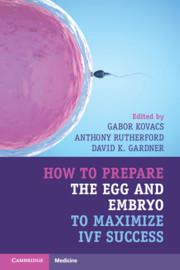Book contents
- How to Prepare the Egg and Embryo to Maximize IVF Success
- How to Prepare the Egg and Embryo to Maximize IVF Success
- Copyright page
- Contents
- Contributors
- Section 1 Oocyte Recruitment
- Section 2 Stimulation for IVF
- Section 3 Supplements to Improve Oocytes
- Section 4 Oocyte and Embryo Culture
- Section 5 Embryo Selection and Transfer
- Index
- References
Section 3 - Supplements to Improve Oocytes
Published online by Cambridge University Press: 04 January 2019
- How to Prepare the Egg and Embryo to Maximize IVF Success
- How to Prepare the Egg and Embryo to Maximize IVF Success
- Copyright page
- Contents
- Contributors
- Section 1 Oocyte Recruitment
- Section 2 Stimulation for IVF
- Section 3 Supplements to Improve Oocytes
- Section 4 Oocyte and Embryo Culture
- Section 5 Embryo Selection and Transfer
- Index
- References
- Type
- Chapter
- Information
- How to Prepare the Egg and Embryo to Maximize IVF Success , pp. 141 - 204Publisher: Cambridge University PressPrint publication year: 2019



